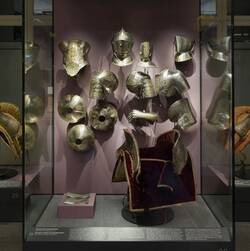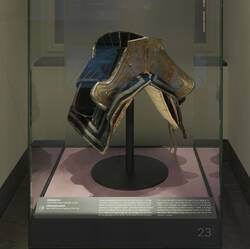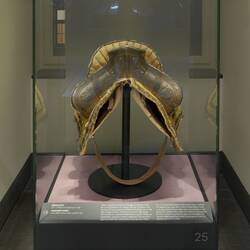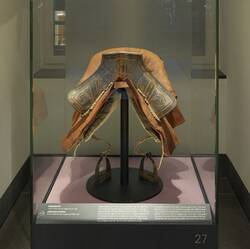Elector Christian I ordered this set of harnesses for a knight and his charger from Anton Peffenhauser in Augsburg, along with various interchangeable parts and four saddles. It was also Christian I, in the summer of 1586, who laid the foundation stone (along with a glass of red wine and six talers) for a separate complex for the Elector’s horses and armoury – the “New Stable”. He loved horses, and the New Stable became a huge establishment serving the royal jousts and tournaments. As a later chronicler put it: “With regard to his impressive court, no German prince (was his equal).”
Horse and rider must have glittered in the sun when they rode out onto the tournament ground ready for the contest. The luxuriant pattern of foliage and flowers is especially eye-catching. It is probably the work of the painter Jörg Sorg. There is evidence that he worked together with Anton Peffenhauser. Sorg compiled a pattern book, which is now in the Württemberg State Library. It contains examples of many of his etched compositions, including some of the numerous decorative designs he made for Peffenhauser.
Between tournament seasons, armours and weapons were stored in the Rüstkammer. Pride in the splendid collection shines through the inventory of 1606: “A gleaming, gilded cuirasse for free tourneys, lined with yellow velvet, which my most gracious Elector Christian, of most praiseworthy and blessed memory, commissioned from Anton Peffenhauser, armoursmith in Augsburg. This includes backplate, breastplate, gorget, spaulders, arm-pieces, gauntlets, a closed helmet with a black-and-yellow plume, short leg-pieces, poleyns, half-greaves, . . . a yellow velvet saddle with a gleaming, gilded metal finish, and the pommel and cantle etched in gold.
An interesting note, throwing light on the culture of the period, was added in either 1615 or 1616. “At His Grace the Elector’s funeral, (the harness) was paraded by Hermann von Barleben.”
This refers to a custom that was common at the Court of Saxony right up until the seventeenth century. At the funeral of an Elector, an official of the royal court headed the procession wearing the ruler’s most precious suit of armour. For the duration of the ceremony, he became the “Freudenritter”, literally, the “joyful knight ”.



